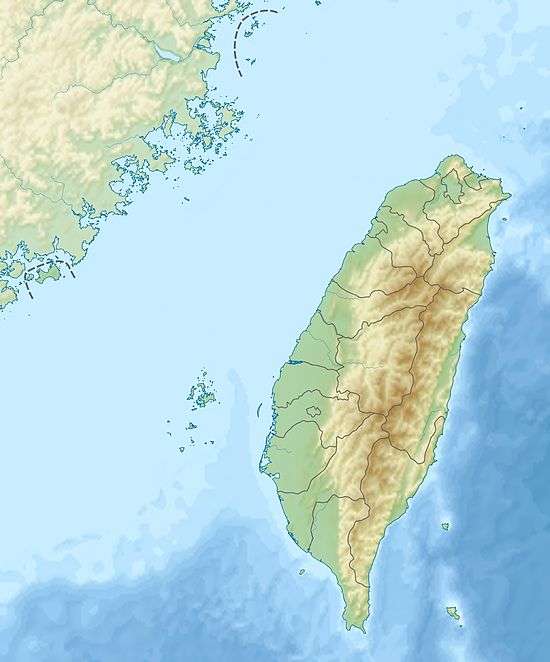Wusanto Reservoir
| Wusanto Reservoir 烏山頭水庫 | |
|---|---|
|
Wushantou Dam (also known as Coral Lake), Tainan. This photo was taken from airplane window. | |
 Location of Wusanto Reservoir 烏山頭水庫 in Taiwan | |
| Country | Taiwan |
| Location | Liujia, Guantian Districts, Tainan |
| Coordinates | 23°12′20.5″N 120°23′24.88″E / 23.205694°N 120.3902444°ECoordinates: 23°12′20.5″N 120°23′24.88″E / 23.205694°N 120.3902444°E |
| Status | In use |
| Construction began | 1920 |
| Opening date | 1930 |
| Dam and spillways | |
| Type of dam | Embankment Dam |
| Impounds | Guantian Creek、Zengwun River (by tunnel) |
| Height | 56 m (184 ft) |
| Length | 1,273 m (4,177 ft) |
| Spillways | Guantian Creek |
| Spillway type | Gated overflow, service |
| Spillway capacity | 1,500 m3/s (53,000 cu ft/s) |
| Reservoir | |
| Creates | Wusanto Reservoir |
| Total capacity | 154,158,000 m3 (5.4440×109 cu ft) |
| Catchment area | 58 km2 (22 sq mi) |
| Surface area | 13 km2 (3,200 acres) |
| Power station | |
| Installed capacity | 50 MW |
| Annual generation | 438,000 KWh |
Wusanto Reservoir (Chinese: 烏山頭水庫; pinyin: Wūshāntóu Shuǐkù), sometimes spelled Wushanto or Wushantou, is a reservoir and scenic area located in Tainan, Taiwan. It is also referred to as Coral Lake due to its zigzagging shoreline. The reservoir was designed by engineer Yoichi Hatta and was the largest in Asia at the time of its completion in 1930.[1]
Overview
Construction of the Wusanto Reservoir began in 1920 and was completed in 1930, with the project financed by the Japanese colonial government. The goal of the project was to provide irrigation for over 100-thousand hectares of farmland in the Chianan area.[2] After construction of the reservoir, the irrigation plain became an important producer of rice for consumption in Taiwan and Japan, with three rice harvests possible each year.[3]
Engineering
The reservoir was built in conjunction with the Chianan Canal, also designed by Hatta.[2] At the time of its completion, Wusanto Reservoir was the largest reservoir in Asia and the third largest in the world.[1] Construction of the reservoir and of the Wusanto Dam used an uncommon semi-hydraulic fill technique, where fine-grained material is placed at the end of an embankment and then washed into its desired position using jets of water; this is a variant of the hydraulic fill technique.[4] Wusanto Reservoir is the only project constructed with the semi-hydraulic fill technique that is still in use anywhere in the world. This process was expensive and time-consuming, but produced a dam which has proven resistant to Taiwan's severe seismic activity.[3]
Scenic area
Today, the Wusanto Reservoir Scenic Area is a popular tourist destination in Tainan. The area includes a memorial and museum for Yoichi Hatta, as well as a replica of the Temple of Heaven in Beijing. Cherry blossom viewing is a popular event in spring. The area is also known for its abundant native flora and fauna.[5]
See also
| Wikimedia Commons has media related to Wusanto Reservoir. |
References
- 1 2 Yang, S.D. "Hatta, Yoichi". Retrieved 18 November 2013.
- 1 2 "Potential World Heritage Sites in Taiwan: Wushantou Reservoir and Jianan Irrigation Waterways". Bureau of Cultural Heritage, Ministry of Culture. Retrieved 18 November 2013.
- 1 2 Liu, Alexandra. "Country Travel, New Style". Retrieved 18 November 2013.
- ↑ Graham, Andrew. "World Wide Web Pages for Dam Design". Retrieved 18 November 2013.
- ↑ "Wusanto Reservoir Scenic Area (Coral Lake)". Retrieved 18 November 2013.